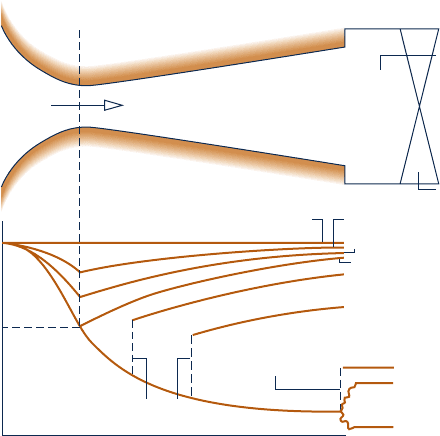Moran M.J., Shapiro H.N. Fundamentals of Engineering Thermodynamics
Подождите немного. Документ загружается.


9.12 Compressible Flow Preliminaries 553
moving away on the left with velocity c 2 DV, pressure p 1 Dp, density r 1 Dr, and
temperature T 1 DT.
At steady state, the conservation of mass principle for the control volume reduces
to m
#
1
5 m
#
2
, or
rAc 5
1
r 1 ¢r
2
A
1
c 2 ¢V
2
On rearrangement
0 5 c¢r 2 r¢V 2 ¢r¢V
0
(9.32)
If the disturbance is weak, the third term on the right of Eq. 9.32 can be neglected,
leaving
¢V 5
1
c
/
r
2
¢r (9.33)
Next, the momentum equation, Eq. 9.31, is applied to the control volume under
consideration. Since the thickness of the wave is small, shear forces at the wall are
negligible. The effect of gravity is also ignored. Hence, the only significant forces act-
ing on the control volume in the direction of flow are the forces due to pressure at
the inlet and exit. With these idealizations, the component of the momentum equation
in the direction of flow reduces to
p
A 2
1
p 1 ¢p
2
A 5 m
#
1
c 2 ¢V
2
2 m
#
c
5 m
#
1
c 2 ¢V 2 c
2
5
1
rAc
21
2¢V
2
or
¢p 5 rc ¢V (9.34)
Combining Eqs. 9.33 and 9.34 and solving for c
c 5
B
¢p
¢r (9.35)
SOUND WAVES. For sound waves the differences in pressure, density, and
temperature across the wave are quite small. In particular, Dr ,, r, justifying the
neglect of the third term of Eq. 9.32. Furthermore, the ratio Dp/Dr in Eq. 9.35 can
be interpreted as the derivative of pressure with respect to density across the wave.
Experiments also indicate that the relation between pressure and density across a
sound wave is nearly isentropic. The expression for the velocity of sound then
becomes
c 5
B
a
0p
0
r
b
s
(9.36a)
or in terms of specific volume
c 5
B
2y
2
a
0p
0y
b
s
(9.36b)
The velocity of sound is an intensive property whose value depends on the state of
the medium through which sound propagates. Although we have assumed that sound
propagates isentropically, the medium itself may be undergoing any process.
Means for evaluating the velocity of sound c for gases, liquids, and solids are intro-
duced in Sec. 11.5. The special case of an ideal gas will be considered here because it
is used extensively later in the chapter. For this case, the relationship between pressure
and specific volume of an ideal gas at fixed entropy is py
k
5 constant, where k is the
velocity of sound
c09GasPowerSystems.indd Page 553 7/19/10 10:27:51 AM users-133 c09GasPowerSystems.indd Page 553 7/19/10 10:27:51 AM users-133 /Users/users-133/Desktop/Ramakant_04.05.09/WB00113_R1:JWCL170/New/Users/users-133/Desktop/Ramakant_04.05.09/WB00113_R1:JWCL170/New

554 Chapter 9
Gas Power Systems
specific heat ratio (Sec. 6.11.2). Thus,
1
0
p
/
0y
2
s
52k
p
/
y, and Eq. 9.36b gives c 5 1k
p
y.
Or, with the ideal gas equation of state
c 5 1kRT
1
ideal gas
2
(9.37)
to illustrate the use of Eq. 9.37, let us calculate the velocity of
sound in air at 300 K (5408R) and 650 K (11708R) From Table A-20 at 300 K,
k 5 1.4. Thus
c 5
B
1.4a
8314
28.97
N ? m
k
g
? K
b1300 K2`
1 k
g ? m
/
s
2
1 N
`5 347
m
s
a1138
ft
s
b
At 650 K, k 5 1.37, and c 5 506 m/s (1660 ft/s), as can be verified. As examples in
English units, consider next helium at 4958R (275 K) and 10808R (600 K). For a
monatomic gas, the specific heat ratio is essentially independent of temperature and
has the value k 5 1.67. Thus, at 4958R
c 5
B
1.67
a
1545
4
ft ? lbf
l
b
? 8R
b
14958R2
`
32.2 lb ? ft
/
s
2
1 l
b
f
`
5 3206
ft
s
a
977
m
s
b
At 10808R, c 5 4736 ft/s (1444 m/s), as can be verified. b b b b b
Mach Number
In subsequent discussions, the ratio of the velocity V at a state in a flowing fluid to
the value of the sonic velocity c at the same state plays an important role. This ratio
is called the Mach number M
M 5
V
c
(9.38)
When M . 1, the flow is said to be supersonic; when M , 1, the flow is subsonic;
and when M 5 1, the flow is sonic. The term hypersonic is used for flows with Mach
numbers much greater than one, and the term transonic refers to flows where the
Mach number is close to unity.
Mach number
supersonic
subsonic
BIOCONNECTIONS For centuries, physicians have used sounds emanating
from the human body to aid diagnosis. Since the early nineteenth century, stetho-
scopes have enabled more effective sound detection. Sounds within the human
body have also interested researchers. For instance, in the 1600s an observer described a
phenomenon that now mainly serves as a diversion: Place your thumbs over your ear open-
ings so the ear canals are completely covered. Then, with elbows raised, tighten your hands
into fists and hear muscular noise as a soft distant rumbling.
Today’s medical researchers and practitioners use sound in various ways. Researchers
have found that during strong and repeated activity, the wrist muscles of people with
untreated Parkinson’s disease produce sound at much lower frequencies than those of
healthy individuals. This knowledge may prove useful in monitoring muscle degeneration
in Parkinson’s patients or aid in early diagnosis of this debilitating disease.
A more commonly encountered sound-related method in medical practice is the use of
sound at frequencies above that audible by the human ear, known as ultrasound. Ultrasound
imaging allows physicians to peer inside the body and evaluate solid structures in the
abdominal cavity. Ultrasound devices beam sound waves into the body and collect return
echoes as the beam encounters regions of differing density. The reflected sound waves
produce shadow pictures of structures below the skin on a monitor screen. Pictures show
the shape, size, and movement of target objects in the path of the beam.
c09GasPowerSystems.indd Page 554 7/19/10 10:27:52 AM users-133 c09GasPowerSystems.indd Page 554 7/19/10 10:27:52 AM users-133 /Users/users-133/Desktop/Ramakant_04.05.09/WB00113_R1:JWCL170/New/Users/users-133/Desktop/Ramakant_04.05.09/WB00113_R1:JWCL170/New

9.13 Analyzing One-Dimensional Steady Flow in Nozzles and Diffusers 555
9.12.3
Determining Stagnation State Properties
When dealing with compressible flows, it is often convenient to work with properties
evaluated at a reference state known as the stagnation state. The stagnation state is
the state a flowing fluid would attain if it were decelerated to zero velocity isentropi-
cally. We might imagine this as taking place in a diffuser operating at steady state. By
reducing an energy balance for such a diffuser, it can be concluded that the enthalpy
at the stagnation state associated with an actual state in the flow where the specific
enthalpy is h and the velocity is V is given by
h
o
5 h 1
V
2
2
(9.39)
The enthalpy designated here as h
o
is called the stagnation enthalpy. The pressure
p
o
and temperature T
o
at a stagnation state are called the stagnation pressure and
stagnation temperature, respectively.
Obstetricians commonly use ultrasound to assess the fetus during pregnancy. Emer-
gency physicians use ultrasound to assess abdominal pain or other concerns. Ultrasound
is also used to break up small kidney stones.
Cardiologists use an ultrasound application known as echocardiography to evaluate the
heart and its valve function, measure the amount of blood pumped with each stroke, and
detect blood clots in veins and artery blockage. Among several uses of echocardiography
are the stress test, where the echocardiogram is done both before and after exercise, and
the transesophageal test, where the probe is passed down the esophagus to locate it closer
to the heart, thereby enabling clearer pictures of the heart.
stagnation state
stagnation pressure
and temperature
9.13 Analyzing One-Dimensional Steady
Flow in Nozzles and Diffusers
Although the subject of compressible flow arises in a great many important areas of
engineering application, the remainder of this presentation is concerned only with
flow through nozzles and diffusers. Texts dealing with compressible flow should be
consulted for discussion of other areas of application.
In the present section we determine the shapes required by nozzles and diffusers
for subsonic and supersonic flow. This is accomplished using mass, energy, entropy,
and momentum principles, together with property relationships. In addition, we study
how the flow through nozzles is affected as conditions at the nozzle exit are changed.
The presentation concludes with an analysis of normal shocks, which can exist in
supersonic flows.
9.13.1
Exploring the Effects of Area Change in Subsonic
and Supersonic Flows
The objective of the present discussion is to establish criteria for determining whether
a nozzle or diffuser should have a converging, diverging, or converging–diverging
shape. This is accomplished using differential equations relating the principal vari-
ables that are obtained using mass and energy balances together with property rela-
tions, as considered next.
stagnation enthalpy
c09GasPowerSystems.indd Page 555 7/19/10 10:27:53 AM users-133 c09GasPowerSystems.indd Page 555 7/19/10 10:27:53 AM users-133 /Users/users-133/Desktop/Ramakant_04.05.09/WB00113_R1:JWCL170/New/Users/users-133/Desktop/Ramakant_04.05.09/WB00113_R1:JWCL170/New

556 Chapter 9
Gas Power Systems
GOVERNING DIFFERENTIAL EQUATIONS. Let us begin by considering a
control volume enclosing a nozzle or diffuser. At steady state, the mass flow rate is
constant, so
r
A
V 5 constant
In differential form
d
1
rAV
2
5 0
AV dr 1 rA dV 1 rV dA 5 0
or on dividing each term by rAV
d
r
r
1
dV
V
1
dA
A
5 0
(9.40)
Assuming
Q
#
cv
5 W
#
cv
5 0 and negligible potential energy effects, an energy rate
balance reduces to give
h
2
1
V
2
2
2
5 h
1
1
V
2
1
2
Introducing Eq. 9.39, it follows that the stagnation enthalpies at states 1 and 2 are
equal: h
o2
5 h
o1
. Since any state downstream of the inlet can be regarded as state 2,
the following relationship between the specific enthalpy and kinetic energy must be
satisfied at each state
h 1
V
2
2
5 h
o1
1constant2
In differential form this becomes
dh
52
V
dV
(9.41)
This equation shows that if the velocity increases (decreases) in the direction of flow,
the specific enthalpy must decrease (increase) in the direction of flow.
In addition to Eqs. 9.40 and 9.41 expressing conservation of mass and energy,
relationships among properties must be taken into consideration. Assuming the flow
occurs isentropically, the property relation (Eq. 6.10b)
T ds 5 dh 2
d
p
r
reduces to give
dh 5
1
r
dp
(9.42)
This equation shows that when pressure increases or decreases in the direction of
flow, the specific enthalpy changes in the same way.
Forming the differential of the property relation p 5 p(r, s)
dp 5
a
0p
0r
b
s
dr 1
a
0p
0s
b
r
ds
The second term vanishes in isentropic flow. Introducing Eq. 9.36a, we have
dp 5 c
2
dr (9.43)
which shows that when pressure increases or decreases in the direction of flow, den-
sity changes in the same way.
Additional conclusions can be drawn by combining the above differential equa-
tions. Combining Eqs. 9.41 and 9.42 results in
1
r
dp 52V dV
(9.44)
c09GasPowerSystems.indd Page 556 7/19/10 10:27:54 AM users-133 c09GasPowerSystems.indd Page 556 7/19/10 10:27:54 AM users-133 /Users/users-133/Desktop/Ramakant_04.05.09/WB00113_R1:JWCL170/New/Users/users-133/Desktop/Ramakant_04.05.09/WB00113_R1:JWCL170/New

9.13 Analyzing One-Dimensional Steady Flow in Nozzles and Diffusers 557
which shows that if the velocity increases (decreases) in the direction of flow, the
pressure must decrease (increase) in the direction of flow.
Eliminating dp between Eqs. 9.43 and 9.44 and combining the result with Eq. 9.40
gives
dA
A
52
dV
V
c
1 2
a
V
c
b
2
d
or with the Mach number M
dA
A
52
dV
V
11 2 M
2
2
(9.45)
VARIATION OF AREA WITH VELOCITY. Equation 9.45 shows how area
must vary with velocity. The following four cases can be identified:
Case 1: Subsonic nozzle. dV . 0, M , 1 1 dA , 0: The duct converges in the
direction of flow.
Case 2: Supersonic nozzle. dV . 0, M . 1 1 dA . 0: The duct diverges in the
direction of flow.
Case 3: Supersonic diffuser. dV , 0, M . 1 1 dA , 0: The duct converges in the
direction of flow.
Case 4: Subsonic diffuser. dV , 0, M , 1 1 dA . 0: The duct diverges in the direc-
tion of flow.
The conclusions reached above concerning the nature of the flow in subsonic
and supersonic nozzles and diffusers are summarized in Fig. 9.30. From Fig. 9.30a,
we see that to accelerate a fluid flowing subsonically, a converging nozzle must be
used, but once M 5 1 is achieved, further acceleration can occur only in a diverg-
ing nozzle. From Fig. 9.30b, we see that a converging diffuser is required to decel-
erate a fluid flowing supersonically, but once M 5 1 is achieved, further decelera-
tion can occur only in a diverging diffuser. These findings suggest that a Mach
number of unity can occur only at the location in a nozzle or diffuser where the
cross-sectional area is a minimum. This location of minimum area is called the
throat.
The developments of this section have not required the specification of an equa-
tion of state; thus, the conclusions hold for all gases. Moreover, although the conclu-
sions have been drawn under the restriction of isentropic flow through nozzles and
diffusers, they are at least qualitatively valid for actual flows because the flow through
well-designed nozzles and diffusers is nearly isentropic. Isentropic nozzle efficiencies
(Sec. 6.12) in excess of 95% can be attained in practice.
throat
Fig. 9.30 Effects of area change in subsonic and supersonic flows. (a) Nozzles: V increases;
h, p, and r decrease. (b) Diffusers: V decreases; h, p, and r increase.
M < 1
Subsonic
M > 1
Supersonic
Case 4
(b)
Case 3
M > 1
Supersonic
M < 1
Subsonic
Case 2
(a)
Case 1
c09GasPowerSystems.indd Page 557 7/19/10 10:27:55 AM users-133 c09GasPowerSystems.indd Page 557 7/19/10 10:27:55 AM users-133 /Users/users-133/Desktop/Ramakant_04.05.09/WB00113_R1:JWCL170/New/Users/users-133/Desktop/Ramakant_04.05.09/WB00113_R1:JWCL170/New

558 Chapter 9
Gas Power Systems
9.13.2
Effects of Back Pressure on Mass Flow Rate
In the present discussion we consider the effect of varying the back pressure on the
rate of mass flow through nozzles. The
back pressure is the pressure in the exhaust
region outside the nozzle. The case of converging nozzles is taken up first and then
converging–diverging nozzles are considered.
CONVERGING NOZZLES. Figure 9.31 shows a converging duct with stagnation
conditions at the inlet, discharging into a region in which the back pressure p
B
can
be varied. For the series of cases labeled a through e, let us consider how the mass
flow rate m
#
and nozzle exit pressure p
E
vary as the back pressure is decreased while
keeping the inlet conditions fixed.
When p
B
5 p
E
5 p
o
, there is no flow, so m
#
5
0
. This corresponds to case a of Fig. 9.31.
If the back pressure p
B
is decreased, as in cases b and c, there will be flow through the
nozzle. As long as the flow is subsonic at the exit, information about changing condi-
tions in the exhaust region can be transmitted upstream. Decreases in back pressure
thus result in greater mass flow rates and new pressure variations within the nozzle. In
each instance, the velocity is subsonic throughout the nozzle and the exit pressure
equals the back pressure. The exit Mach number increases as p
B
decreases, however,
and eventually a Mach number of unity will be attained at the nozzle exit. The corre-
sponding pressure is denoted by p*, called the critical pressure. This case is represented
by d on Fig. 9.31.
Recalling that the Mach number cannot increase beyond unity in a converging
section, let us consider next what happens when the back pressure is reduced further
to a value less than p*, such as represented by case e. Since the velocity at the exit
equals the velocity of sound, information about changing conditions in the exhaust
region no longer can be transmitted upstream past the exit plane. Accordingly, reduc-
tions in p
B
below p* have no effect on flow conditions in the nozzle. Neither the
pressure variation within the nozzle nor the mass flow rate is affected. Under these
back pressure
Fig. 9.31 Effect of back
pressure on the operation
of a converging nozzle.
p
E
p
o
, T
o
V ≈ 0
p
B
1.0
Exhaust region
Valve to adjust
back pressure
a
a
b
c
e
d
b
c
d
e
p
B
p
p
o
m
·
(a
)
p
E
p
o
1.0
1.0
e
c
b
a
d
p
B
p
o
p*
p
o
c09GasPowerSystems.indd Page 558 7/19/10 10:27:56 AM users-133 c09GasPowerSystems.indd Page 558 7/19/10 10:27:56 AM users-133 /Users/users-133/Desktop/Ramakant_04.05.09/WB00113_R1:JWCL170/New/Users/users-133/Desktop/Ramakant_04.05.09/WB00113_R1:JWCL170/New

conditions, the nozzle is said to be choked. When a nozzle is choked, the mass flow
rate is the maximum possible for the given stagnation conditions. For p
B
less than p*,
the flow expands outside the nozzle to match the lower back pressure, as shown by
case e of Fig. 9.31. The pressure variation outside the nozzle cannot be predicted using
the one-dimensional flow model.
CONVERGING–DIVERGING NOZZLES. Figure 9.32 illustrates the effects of
varying back pressure on a converging–diverging nozzle. The series of cases labeled
a through j is considered next.
c Let us first discuss the cases designated a, b, c, and d. Case a corresponds to
p
B
5 p
E
5 p
o
for which there is no flow. When the back pressure is slightly less than
p
o
(case b), there is some flow, and the flow is subsonic throughout the
nozzle. In accordance with the discussion of Fig. 9.30, the greatest velocity and low-
est pressure occur at the throat, and the diverging portion acts as a diffuser in which
pressure increases and velocity decreases in the direction of flow. If the back pres-
sure is reduced further, corresponding to case c, the mass flow rate and velocity at
the throat are greater than before. Still, the flow remains subsonic throughout and
qualitatively the same as case b. As the back pressure is reduced, the Mach number
at the throat increases, and eventually a Mach number of unity is attained there
(case d). As before, the greatest velocity and lowest pressure occur at the throat, and
the diverging portion remains a subsonic diffuser. However, because the throat
velocity is sonic, the nozzle is now choked: The maximum mass flow rate has been
attained for the given stagnation conditions. Further reductions in back pressure
cannot result in an increase in the mass flow rate.
c When the back pressure is reduced below that corresponding to case d, the flow
through the converging portion and at the throat remains unchanged. Conditions
within the diverging portion can be altered, however, as illustrated by cases e, f, and
g. In case e, the fluid passing the throat continues to expand and becomes supersonic
in the diverging portion just downstream of the throat; but at a certain location an
abrupt change in properties occurs. This is called a normal shock. Across the shock,
there is a rapid and irreversible increase in pressure, accompanied by a rapid decrease
from supersonic to subsonic flow. Downstream of the shock, the diverging duct acts
as a subsonic diffuser in which the fluid continues to decelerate and the pressure
choked flow:
converging nozzle
choked flow:
converging–diverging
nozzle
normal shock
9.13 Analyzing One-Dimensional Steady Flow in Nozzles and Diffusers 559
Fig. 9.32
Effect of back pressure on the operation of a converging–diverging nozzle.
p
E
p
o
, T
o
V ≈ 0
M = 1
p
B
Exhaust region
Throat
Valve to adjust
back pressure
e
g
h
j
i
f
Normal
shock
Normal
shock
c
ba
d
p
p*
c09GasPowerSystems.indd Page 559 7/19/10 10:27:56 AM users-133 c09GasPowerSystems.indd Page 559 7/19/10 10:27:56 AM users-133 /Users/users-133/Desktop/Ramakant_04.05.09/WB00113_R1:JWCL170/New/Users/users-133/Desktop/Ramakant_04.05.09/WB00113_R1:JWCL170/New

560 Chapter 9
Gas Power Systems
increases to match the back pressure imposed at the exit. If the back pressure is
reduced further (case f), the location of the shock moves downstream, but the flow
remains qualitatively the same as in case e. With further reductions in back pressure,
the shock location moves farther downstream of the throat until it stands at the exit
(case g). In this case, the flow throughout the nozzle is isentropic, with subsonic flow
in the converging portion, M 5 1 at the throat, and supersonic flow in the diverging
portion. Since the fluid leaving the nozzle passes through a shock, it is subsonic just
downstream of the exit plane.
c Finally, let us consider cases h, i, and j where the back pressure is less than that cor-
responding to case g. In each of these cases, the flow through the nozzle is not affected.
The adjustment to changing back pressure occurs outside the nozzle. In case h, the
pressure decreases continuously as the fluid expands isentropically through the nozzle
and then increases to the back pressure outside the nozzle. The compression that
occurs outside the nozzle involves oblique shock waves. In case i, the fluid expands
isentropically to the back pressure and no shocks occur within or outside the nozzle.
In case j, the fluid expands isentropically through the nozzle and then expands outside
the nozzle to the back pressure through oblique expansion waves. Once M 5 1 is
achieved at the throat, the mass flow rate is fixed at the maximum value for the given
stagnation conditions, so the mass flow rate is the same for back pressures correspond-
ing to cases d through j. The pressure variations outside the nozzle involving oblique
waves cannot be predicted using the one-dimensional flow model.
9.13.3
Flow Across a Normal Shock
We have seen that under certain conditions a rapid and abrupt change of state called
a shock takes place in the diverging portion of a supersonic nozzle. In a normal shock,
this change of state occurs across a plane normal to the direction of flow. The object
of the present discussion is to develop means for determining the change of state
across a normal shock.
MODELING NORMAL SHOCKS. A control volume enclosing a normal shock
is shown in Fig. 9.33. The control volume is assumed to be at steady state with W
#
cv
5 0,
Q
#
cv
5 0 and negligible effects of potential energy. The thickness of the shock is very
small (on the order of 10
25
cm). Thus, there is no significant change in flow area
across the shock, even though it may occur in a diverging passage, and the forces
acting at the wall can be neglected relative to the pressure forces acting at the
upstream and downstream locations denoted by x and y, respectively.
The upstream and downstream states are related by the following equations:
Mass:
r
x
V
x
5 r
y
V
y
(9.46)
Energy:
h
x
1
V
2
x
2
5 h
y
1
V
2
y
2
(9.47a)
or
h
ox
5 h
o
y
(9.47b)
Momentum:
p
x
2 p
y
5 r
y
V
2
y
2 r
x
V
2
x
(9.48)
Entropy:
s
y
2 s
x
5 s
#
cv
/
m
#
(9.49)
Fig. 9.33 Control volume
enclosing a normal shock.
V
y
, M
y
, T
y
, p
y
h
y
, s
y
xy
Normal shock
V
x
, M
x
, T
x
, p
x
h
x
, s
x
c09GasPowerSystems.indd Page 560 7/19/10 10:27:56 AM users-133 c09GasPowerSystems.indd Page 560 7/19/10 10:27:56 AM users-133 /Users/users-133/Desktop/Ramakant_04.05.09/WB00113_R1:JWCL170/New/Users/users-133/Desktop/Ramakant_04.05.09/WB00113_R1:JWCL170/New

When combined with property relations for the particular fluid under consideration,
Eqs. 9.46, 9.47, and 9.48 allow the downstream conditions to be determined for spec-
ified upstream conditions. Equation 9.49, which corresponds to Eq. 6.39, leads to the
important conclusion that the downstream state must have greater specific entropy
than the upstream state, or s
y
. s
x
.
FANNO AND RAYLEIGH LINES. The mass and energy equations, Eqs. 9.46 and
9.47, can be combined with property relations for the particular fluid to give an equa-
tion that when plotted on an h–s diagram is called a Fanno line. Similarly, the mass
and momentum equations, Eqs. 9.46 and 9.48, can be combined to give an equation
that when plotted on an h–s diagram is called a Rayleigh line. Fanno and Rayleigh
lines are sketched on h–s coordinates in Fig. 9.34. It can be shown that the point of
maximum entropy on each line, points a and b, corresponds to M 5 1. It also can be
shown that the upper and lower branches of each line correspond, respectively, to
subsonic and supersonic velocities.
The downstream state y must satisfy the mass, energy, and momentum equations
simultaneously, so state y is fixed by the intersection of the Fanno and Rayleigh lines
passing through state x. Since s
y
. s
x
, it can be concluded that the flow across the
shock can only pass from x to y. Accordingly, the velocity changes from supersonic
before the shock (M
x
. 1) to subsonic after the shock (M
y
, 1). This conclusion is
consistent with the discussion of cases e, f, and g in Fig. 9.32. A significant increase
in pressure across the shock accompanies the decrease in velocity. Figure 9.34 also
locates the stagnation states corresponding to the states upstream and downstream
of the shock. The stagnation enthalpy does not change across the shock, but there is
a marked decrease in stagnation pressure associated with the irreversible process
occurring in the normal shock region.
Fanno line
Rayleigh line
9.14 Flow in Nozzles and Diffusers of Ideal
Gases with Constant Specific Heats
The discussion of flow in nozzles and diffusers presented in Sec. 9.13 requires no
assumption regarding the equation of state, and therefore the results obtained hold
generally. Attention is now restricted to ideal gases with constant specific heats. This
case is appropriate for many practical problems involving flow through nozzles and
diffusers. The assumption of constant specific heats also allows the derivation of rel-
atively simple closed-form equations.
9.14 Flow in Nozzles and Diffusers of Ideal Gases with Constant Specific Heats 561
Fig. 9.34
Intersection of Fanno and
Rayleigh lines as a solution to the normal
shock equations.
V
y
2
2
V
x
2
2
M = 1 at a and b
M < 1 on upper branches
M > 1 on lower branches
Rayleigh line
Fanno line
h
x
h
ox
p
ox
p
oy
h
ox
= h
oy
h
oy
x
y
a
b
h
s
c09GasPowerSystems.indd Page 561 7/19/10 10:27:57 AM users-133 c09GasPowerSystems.indd Page 561 7/19/10 10:27:57 AM users-133 /Users/users-133/Desktop/Ramakant_04.05.09/WB00113_R1:JWCL170/New/Users/users-133/Desktop/Ramakant_04.05.09/WB00113_R1:JWCL170/New

562 Chapter 9 Gas Power Systems
9.14.1
Isentropic Flow Functions
Let us begin by developing equations relating a state in a compressible flow to the
corresponding stagnation state. For the case of an ideal gas with constant c
p
, Eq. 9.39
becomes
T
o
5 T 1
V
2
2c
p
where T
o
is the stagnation temperature. Using Eq. 3.47a, c
p
5 kR/(k 2 1), together
with Eqs. 9.37 and 9.38, the relation between the temperature T and the Mach number
M of the flowing gas and the corresponding stagnation temperature T
o
is
T
o
T
5 1 1
k 2 1
2
M
2
(9.50)
With Eq. 6.43, a relationship between the temperature T and pressure p of the
flowing gas and the corresponding stagnation temperature T
o
and the stagnation
pressure p
o
is
p
o
p
5
a
T
o
T
b
k
/
1
k21
2
Introducing Eq. 9.50 into this expression gives
p
o
p
5
a
1 1
k 2 1
2
M
2
b
k
/
1
k21
2
(9.51)
Although sonic conditions may not actually be attained in a particular flow, it is
convenient to have an expression relating the area A at a given section to the area
A* that would be required for sonic flow (M 5 1) at the same mass flow rate and
stagnation state. These areas are related through
rAV 5 r*A*V*
where r* and V* are the density and velocity, respectively, when M 5 1. Introducing the
ideal gas equation of state, together with Eqs. 9.37 and 9.38, and solving for A/A*
A
A*
5
1
M
p
*
p
a
T
T*
b
1
y
2
5
1
M
p*
/
p
o
p
/
p
o
a
T
/
T
o
T*
/
T
o
b
1
y
2
where T* and p* are the temperature and pressure, respectively, when M 5 1. Then
with Eqs. 9.50 and 9.51
A
A*
5
1
M
ca
2
k 1 1
ba
1 1
k 2 1
2
M
2
bd
1
k11
2
/
2
1
k21
2
(9.52)
The variation of A/A* with M is given in Fig. 9.35 for k 5 1.4. The figure
shows that a unique value of A/A* corresponds to any choice of M.
However, for a given value of A/A* other than unity, there are two pos-
sible values for the Mach number, one subsonic and one supersonic. This
is consistent with the discussion of Fig. 9.30, where it was found that a
converging–diverging passage with a section of minimum area is required
to accelerate a flow from subsonic to supersonic velocity.
Equations 9.50, 9.51, and 9.52 allow the ratios T/T
o
, p/p
o
, and A/A* to
be computed and tabulated with the Mach number as the single indepen-
dent variable for a specified value of k. Table 9.2 provides a tabulation
of this kind for k 5 1.4. Such a table facilitates the analysis of flow through
nozzles and diffusers. Equations 9.50, 9.51, and 9.52 also can be readily
evaluated using calculators and computer software such as Interactive
Thermodynamics: IT.
Fig. 9.35 Variation of A/A* with Mach
number in isentropic flow for k 5 1.4.
A
M
A*
0
0 0.5 1.0 1.5 2.0 2.5 3.0
0.5
1.0
1.5
2.0
2.5
3.0
c09GasPowerSystems.indd Page 562 7/19/10 10:27:57 AM users-133 c09GasPowerSystems.indd Page 562 7/19/10 10:27:57 AM users-133 /Users/users-133/Desktop/Ramakant_04.05.09/WB00113_R1:JWCL170/New/Users/users-133/Desktop/Ramakant_04.05.09/WB00113_R1:JWCL170/New
